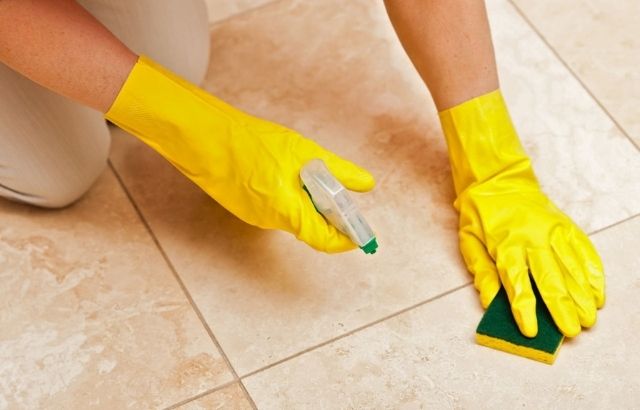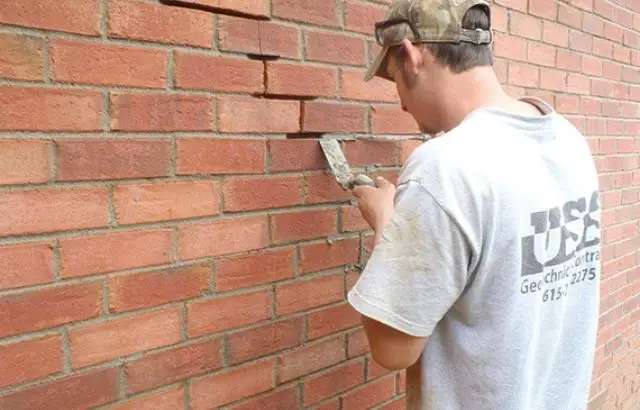While grout sealing your tile flooring, there is a possibility that some of the grout sealers will drip onto the surrounding tile surfaces and give them a dull appearance. This article will provide you with the proper guidance on how to remove grout sealer from tiles.
The grout sealer is applied after installing new tile and grout and after some repair work is done on the grout.
If you notice grout sealer falling on the tile surface, it should be removed instantly with a clean rag while grout sealing.
For best results, soak a sponge in warm water and wipe the sealer off with it. Then, rub the surface with a vinegar solution made of a few drops of water and white vinegar. Thus, the tile surface will be free of grout sealer.
But it often occurs that the sealer remains on longer and dries out. There are two types of grout sealers on the market.
The first is a membrane-forming sealer, while the second is a penetrating sealer.
Both kinds are very water-resistant since they are used to shield the grout surface from the negative effects of moisture.
Therefore, you cannot clean the dry sealer with plain water.
Learn to how to dry water under wood floors.
It would help to be a little more effective. Chemical-based sealer strippers are widely used to remove grout sealers from the tile surface.
It can be purchased in your local distribution chains. Step-by-step instructions for removing grout sealer residue from tile are as follows:
How to Remove Grout Sealer from Tiles
Removing the sealer
By learning more about the main type of sealer, how do you remove them?
For a surface sealer
- Pro strip tile sealer remover is usually one of the most purchased sealers. This is because it is very efficient. Check this guide to learn to waterproof a shower without removing tiles.
- To remove the sealer, you must remove it from the surface with strong products designed to devour the sealer.
- You will also need to aggressively scrub the tile until all of the sealers are removed. Learn to remove porcelain floor tiles without breaking them.
- Ensuring you have good ventilation before applying any sealing is important. Otherwise, it could be a messy job.
- Always test in an inconspicuous area before and after the test allow the stripper to sit for about 10 minutes.
- If the sealer begins to soften, you can continue to apply it throughout the room.
- Follow the manufacturer’s instructions thoroughly and wear safety equipment, including safety goggles, plastic gloves, and masks, to avoid aspiration of the strong chemicals.
- Good ventilation is very important when using paint strippers, so open your windows and turn on fans to circulate the air.
For penetrating sealers
- The process is a little more rigorous.
- Sometimes it is advisable to carry out several rounds of stripper to remove it completely.
- Both types of sealers from tile require a stripper solution, but the concentration and type of stripper will depend on the sealer being applied.
- Always use a soft bristle brush to avoid damaging the tiles.
- Work the stripper solution deep into the tiles and pour more as needed.
- You probably have a large room so that you can use a sealer residue remover.
- It is left on the tiles for the necessary time until it starts to bubble.
- Then scrape off the brush gently and dispose of it in a metal container or bucket.
- A wire-bristle brush can be used to get rid of stubborn stains but do so carefully not to scratch the tile.
- Once removal is complete, vacuum up any remaining residue with a wet/dry vacuum.
- Rinse your floor with warm water and repeat the vacuuming until all is gone. Once the sealer removal is complete, the tiles should look brighter or lighter in color.
What Type of Sealant has been used, and how is it Known?
- At first glance, it can be a little tricky to know exactly what type of tile sealer was applied to your tile.
- Also, a lacquer thinner can be applied to an experimental area of the tile.
- If once you apply it, no changes occur
- If it appears to erode the sealer, it is probably a surface sealer.
- Penetrating sealers tend to make the tiles look a little darker, as they are completely absorbed into the tile.
- If you have a piece of the original tile, you can compare a tile piece with the installed one to see color differences.
- If the installed tile looks darker instead of brighter, it has probably been treated with a penetrating sealer.
Penetrating Sealer vs. Surface Sealer
- Before deciding to tile sealer peeling off, it is important to know what type you currently have applied to your tile. Learn how to clean the stone tile shower.
- There are two types of sealants commonly used: penetrating and surface sealers and the difference between the two will determine what you will need to peel off.
- A penetrating sealant’s performance is different from that of a surface sealant in that it must have penetrated the tile for at least 15 to 20 minutes.
- This ensures that the sealer is fully absorbed into the tile surface and deep into the tile pores and grout.
- After the proper set time, any remaining sealer should be wiped off. Otherwise, an irregular staining effect may occur that is very difficult to remove.
- For a surface sealer, the material is applied as a coating over the tile and grout, which forms a non-porous, stain-resistant layer.
- With this sealer, the tiles’ natural colors are enhanced and usually give the tiles a subtle sheen.
- Any unglazed tile, such as porcelain, should be sealed, and remove sealer from porcelain tile before adding grout to prevent it from staining the tile.
- The purpose of both types of sealers is to protect the tiles, prevent staining and help them retain their beauty and luster.
Why Remove the Tile Sealer?
Depending on the type of tile, there may be several reasons you need or want to remove the sealer from the tile. In some cases, the sealer was applied too thickly, which can interfere with the tiles’ beautiful appearance. Certain sealers are made to absorb the tile rather than be placed directly on it, eliminating the thickness factor.
There can be several reasons why your sealer from tile is too thick, but in most cases, it is because it was not applied correctly. The sealer needs time to absorb, and any excess should be wiped off the surface so it doesn’t dry and set. If you have areas of the house with a lot of foot traffic, your sealer may wear unevenly in places.
This is usually quite obvious; as you will notice patches where sealant remains and other areas where it is worn away. It is recommended that you remove the tile sealer completely in this case and reapply it for an even finish. Some sealers can become streaky or dusty; creating a “dirty” look that you can’t seem to get rid of.
In other cases, dirt and grime have become deeply embedded in the surface sealer, creating that constant dirt look.
Why you Need to Seal the Grout?
Once the grout is clean and beautiful again, be sure to reseal it right away.
All that scrubbing and cleaning will have worn away any remaining seal, and you don’t want your hard work to go to waste.
Perhaps the question is being asked; this sounds very complicated. Do I have to seal the grout lines?
Well, the answer is: yes.
Unless you have an epoxy grout, everything must be sealed.
It may seem like an unnecessary step immediately after you have cleaned it, and it looks so nice and new. However, the grout will not stay nice for long unless you seal it.
Read More: How To Clean Sticky Tile Floors
Grout sealer is key to maintaining a clean and attractive tile surface. It increases stain resistance, durability, and moisture resistance.
You should seal all grout that does not already contain a sealer in the mix, and you should also seal natural stone tiles. Porcelain and glazed ceramic tiles do not require sealing.
Sealing is not a one-time event. Stone tiles and grout require new applications of sealers every few years to ensure they are fully protected.
A sealer stripper should be used only after the sealer has properly set into the grout surface.
While applying the stripper, be careful not to get into the grout area and remove the sealer from there. It will be a disaster if you remove the stone sealer.
Some people use sharp objects such as a razor to remove the grout sealer from the tiles, but it can leave scratches on the tiles’ surface.
Therefore, instead of using sharp objects that can damage the tiles, try to follow the above instructions to remove the tiles’ grout cleaner.
How to Remove Grout Sealer from Tiles: FAQs
Are there problems if I apply grout sealer on the tile?
Avoid getting grout sealer on the tile itself, although a little doesn’t matter.
The theory behind spray sealers is that sealer fluids penetrate porous materials (sanded grout) but not smooth surfaces.
Does vinegar remove grout sealer?
If you notice the sealer falling on the tile surface, it should be removed instantly with a clean rag. For best results, soak a sponge in warm water and wipe the sealer off with it. Then, rub the surface with a vinegar solution made of equal amounts of water and white vinegar.
How do you remove old grout sealant?
If the grout has an old, worn layer of grout sealant that allows water to pool, use a floor finish stripper to remove the sealant from the surface.
Conclusion
The porcelain tile in your home is important. It brings an elegant style to your home that is a must. Taking care of residue from tiles is of utmost importance.
If the tile sealer that binds these tiles together is sticking out, it could be aesthetically hideous. It is important to stay calm and be a little patient. With the tips read above, you will be able to fix this, even without an expert’s help.




